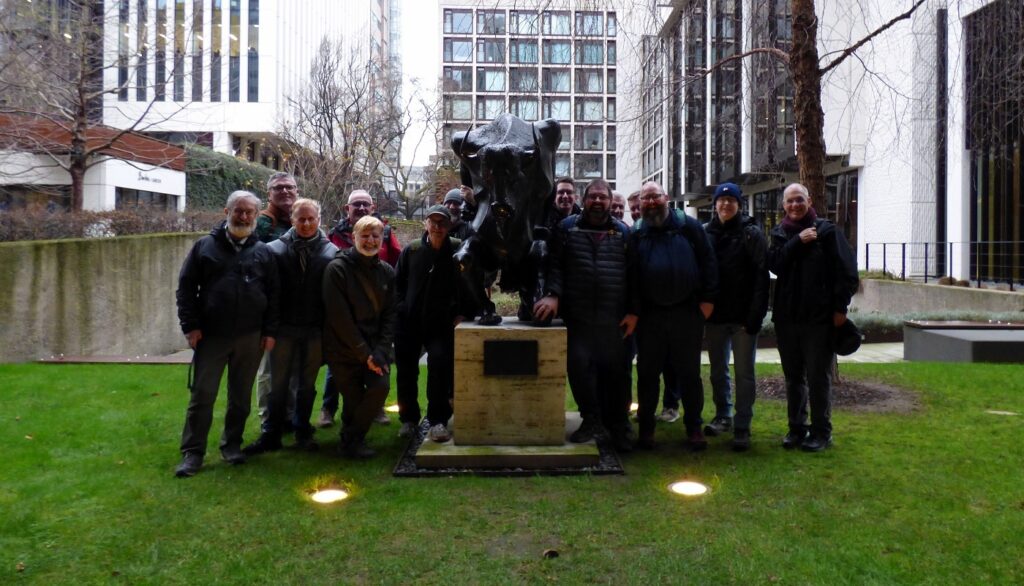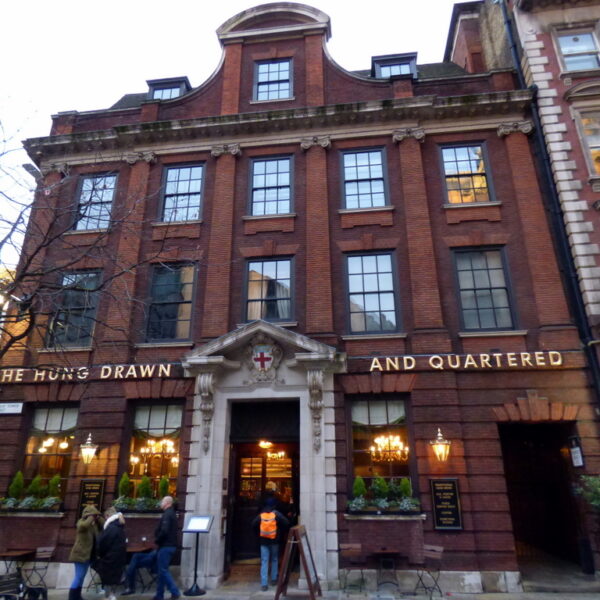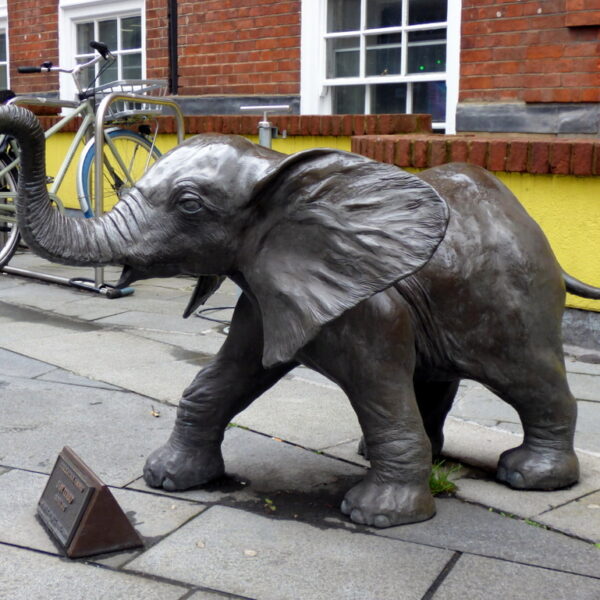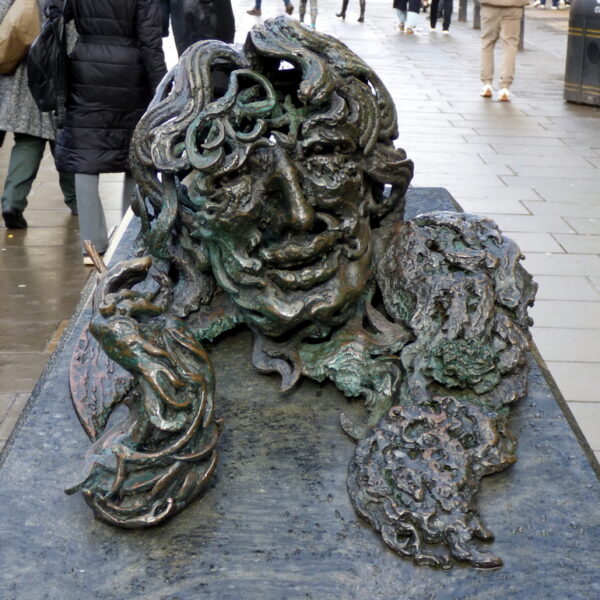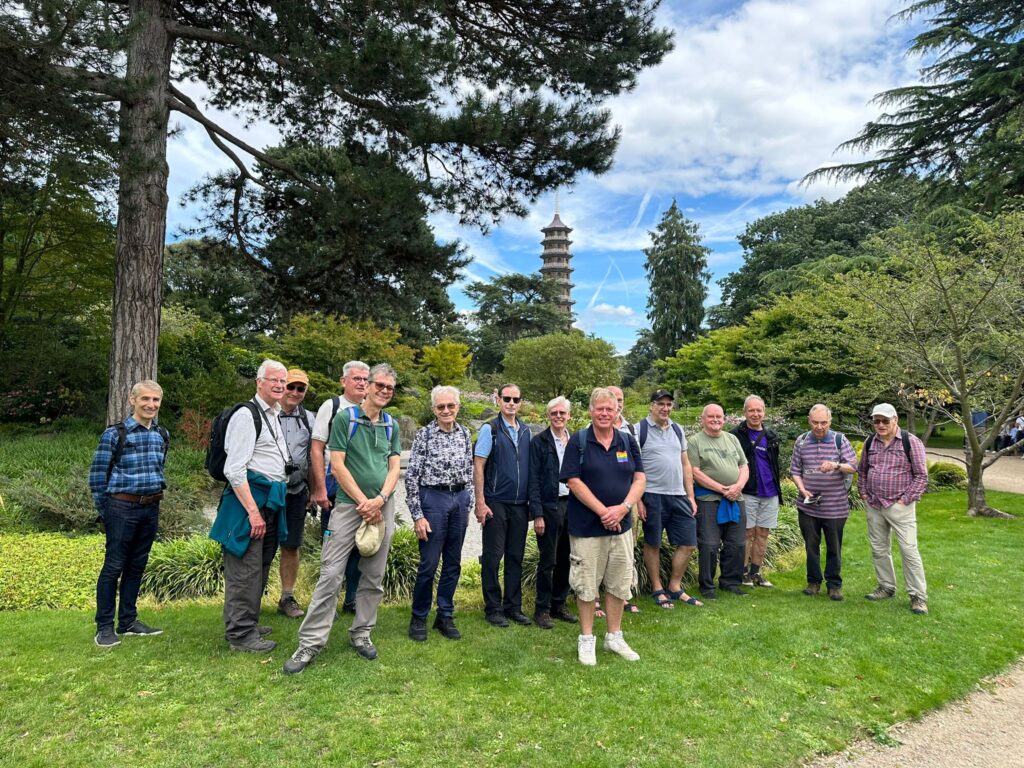This walk was a linear route from Hyde Park to Tower Hill, a circuitous route to absorb artworks and artefacts with history relevant to LGBT interests.
The usual stats:
- Event led and compiled by Khris R.
- Attendance 10 Feb 2024: 15 people at the start, 14 people at the end. 24 Feb 2024: 9 people.
- Distance: 6.7 miles (10.8 km).
- Altitude per GPS: low 154ft (47m), high 357ft (109m), climb and descent figures recorded were meaningless because of breakages in the GPS signal caused by a dense urban environment, start 301ft (92m).
- Time: start 11:10, end 16:46 (sunset 17:05), lunch 45 minutes, other breaks included in walk-time.
- Speed: moving arithmetic average 1.38 mph (2.26 kph), lower than normal reflecting the nature of the route as a guided tour, therefore long pauses.
- Terrain: pavement, lawn.
- Weather 10 Feb 2024: overcast, some drizzle, range between 7°C and 12°C, max 6mph southerly wind.
- Number of sewage works: 0.
- Number of churches: 9, plus 1 bonus ruin.
- Number of golf courses: 0.
- Numbers of Waitroses: 0.
- Event metrics for 24 Feb 2024 not recorded.
Same-sex love and desire and non-binary gender identities have been understood in different ways throughout history. Our modern understanding of lesbian, gay, bisexual and trans-sexual identities are very recent, dating from late 19th century, continuing up to the present day. In the past, people saw sexuality as something one does, rather than something one is. Stories abound of people dressing and living their lives in ways that cross the gender boundary of male and female. And London has a lot of it!
In this second February of GOC’s tour through LGBT History Month, the history we (literally) bumped into touched upon some themes familiar from the first such tour in 2023 and introduced some new characters and hidden histories.
Some historic highlights of 2024’s tour:
- St James Park. In the 1720s, it was a major cruising ground, especially for soldiers from the nearby barracks. London being a mercantile city, somebody found a way to money from this. In particular, John Mitchell earned some cash by blackmail. He bragged about receiving 4 of 5 guineas a night from threats to exposure. By the 1730s, a special police force had cleaned up the park, ending the park’s life as a cruising ground.
- London School of Economics, “LSE”. Students Aubrey Walter and Bob Mellors met in September 1970 at a conference in Philadelphia. They held the first meeting of the UK branch of the Gay Liberation Front on 30 October 1970 in the basement of the St Clement’s Building.
- Still at LSE, in 1989, the student society for lesbian and gay interests added bisexual to its name, likely being the first such group in the UK to recognise bisexual interests.
- Again still at LSE, the Hall-Carpenter Archives contains 2,000 boxes of material relating to LGBT activism in the UK. Most of the archive dates from 4 September 1957, after the publication of the Wolfenden Report. The Wolfenden Report looked into the incidence of why so many well-known men had been convicted of homosexual offences. From 1945 to 1954, there were 1,069 men in prison in England & Wales for homosexual acts, with a mean age of 37 years.
- The Old Bailey. James Pratt and John Smith were executed at the Old Bailey on 27 November 1835, being the last men executed in Britain for the crime of sodomy.
- Still at the Old Bailey. On 13 December 1698, Captain Edward Rigby was fined £1,000 and stood in the pillory 3 times for the crime of buggery. After one trial had acquitted him, he was framed in a sting operation.
- St Bart’s Hospital has the only known statue of Henry VIII in London. Ironically, in spite of Henry being somewhat less than sympathetic towards LGBT interests, the statute portrays Henry with a disproportionately large codpiece.
- Still at St Bart’s Hospital. Derek Jarman died at the hospital in February 1994. Having campaigned to reduce the act of sex-same consent from 21 to 16, on the day of his death, the House of Commons agreed to reduce the age to 18.
- Cheapside. John/Eleanor Rykener was a transvestite prostitute whose pitch was Cheapside, and who was arrested in 1395 for cross-dressing. The records of this arrest and its investigations are the only records of the period which refer to same-sex intercourse. The records revealed that Rykener was quite open about his trade: amongst his client base, he cited priests, monks and nuns, preferring priests because they “paid better than others”. The records are also quite rich in detail, revealing Franciscan and Carmelite friars, and foreigners.
- The Royal Exchange was a popular cruising area in the 1700s, known as the time as the “molly market”. From 1700 onwards, a new kind of participant caused excitement, earning the name “swarthy Buggerantoes”. In 1707, a group of at least 40 gay men were arrested, of whom 3 committed suicide while in prison. One of the dead was Jermain, clerk of the church of St Dunstan’s in the East, who killed himself by cutting his throat with a razor.
- Tower Hill. James I of England (a.k.a. James VI of Scotland) was known to prefer men over women. He was 13 when he met his first favourite, Esmé Stuart, who was 37 and become James’ mentor. James inverted the pattern in later life, becoming a mentor to Robert Carr, Earl of Somerset, from 1607. In 1614, James met George Villiers. Villiers clearly appealed to James, because over subsequent decades, James bestowed upon Villiers four honours, ending with the dukedom of Buckingham, being then the sole English duke who was not a member of the royal family.
The route revealed how very different areas of London can be. Hyde Park, the West End, Aldwych and Tower Hill were all very busy. The Barbican and Leadenhall Market were fairly busy. The endless, disorientating narrow back-passages of the City were quiet and soulless.
Lunch was at the Barbican, on the main plaza immediately in front of the theatre's main entrance. Whilst we ate packed lunches, there were two cafés from which either a snack or a quick main meal was possible. The parallels with student life in a red-brick or grey-slab university campus were quite stark.
Churches:
- St Martin in the Fields, Trafalgar Square.
- St Mary le Strand, Strand.
- St Sepulchre-without-Newgate, Holborn.
- St Bartholomew The Less, off Gilspur Street: not seen on the route, so excluded from the church count. It hides inside the hospital complex.
- St Bartholomew The Great, Cloth Fair.
- St Giles without Cripplegate, Barbican.
- St Lawrence Jewry next Guildhall, Gresham Street.
- St Michael’s Cornhill, Cornhill.
- Guild church of St Margaret Pattens, Rood Lane.
- ruins of St Dunstan in the East, St Dunstan’s Hill.
- All Hallows by the Tower, Gloucester Court.
Optional pub stop
- The Hung Drawn & Quartered, a Fullers pub, Tower Hill, London.
For more pictures, see https://photos.app.goo.gl/2vby1bCLc9XrJAFYA.
We thank Khris for researching and compiling the event.
Words by Martin Thornhill. Pictures by Peter O’Connor.

